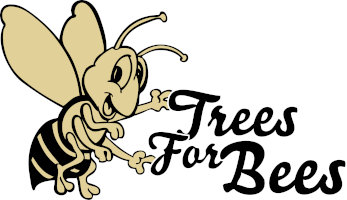
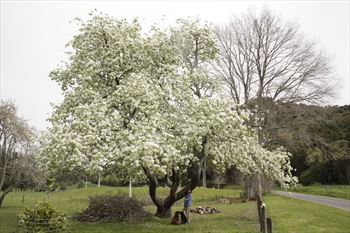
This heritage edible pear tree (Pyrus communis)in full bloom benefits bees hugely
Photographer:Jean- Noel Galliot
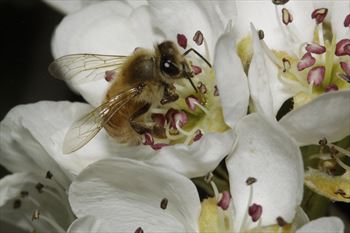
Pear flower with bee collecting pollen. Anthers in all stages of opening deliver pollen throughout the day. Photo: Jean-Noël Galliot © Trees for Bees NZ.
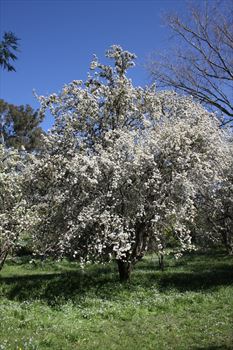
Heritage Pear Tree with dense blossoms.
Photographer:Jean-Noel Galliot
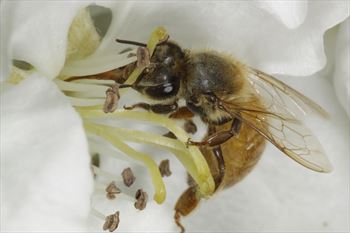
Pear flower with bee taking nectar. The bee ‘tongue’ (proboscis) is extended into the centre of the flower for sipping nectar. Photo: Jean-Noël Galliot © Trees for Bees NZ.
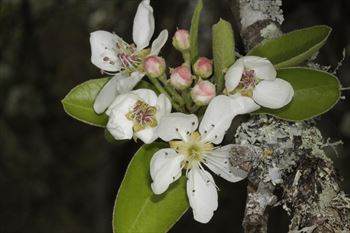
Pear flowers showing several stages of maturity of the flowers. Anthers open sequentially all day long presenting pollen throughout the day.
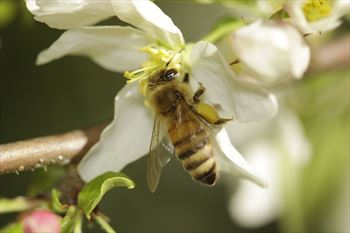
Apple flower (Malus sieboldii) with honey bee probably collecting the pollen as shown in the large pollen loads in the corbiculae (pollen baskets on the hind legs). Because it has the pollen loads it is probably not taking nectar but it is not clear from this photo because we cannot see where the tongue is.
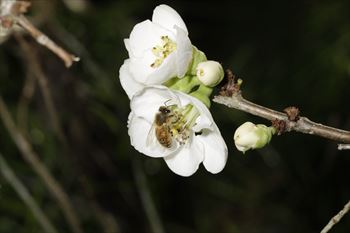
Flowering quince (Chaenomeles japonica) the Japanese flowering quince
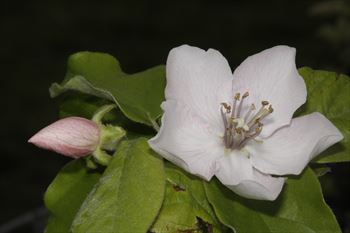
Edible quince (Cyonia oblonga) flower and branch.
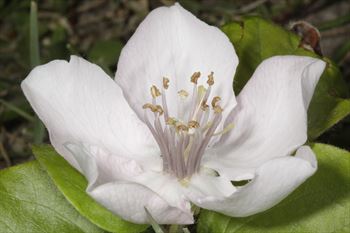
Edible quince (Cydonia oblonga) close up of the flower -- an open dish giving easy access to the pollen and the nectar.
Star Performer Status
In the Rose family, the pipfruit trees, (e.g., pears, apples, crab apples, and quinces) are Star Performers because of their massive flower density on the tree and the high protein content in the pollen (22%–28%). The trees or shrubs are usually deciduous with flowers opening before the leaves. Most species flower in spring with different early and late varieties.
Introduction
In each group there are both edible cultivars and ornamental inedible varieties. For example, the ‘flowering quince’ (Chaenomeles japonica) is grown ornamentally for the flowers, not for their fruits (although they are edible), while the closely related Cydonia oblonga and Pseudocydonia sinensis are the edible quinces.
There are both edible and ornamental cultivars of apples, pears and crab apples too. Consult your local nursery. Avoid any that have double flowers or other modifications that reduce the quantity and presentation of pollen and nectar. If the spread of weeds by bird dispersal of fruits and seeds is an issue, then choose cultivars with large fruits that don’t attract birds.
Domestic Apple (Malus domestica cultivars)
Crab Apple (Malus species)
European pear (Pyrus communis cultivars
Ornamental pear (e.g., Pyrus calleryan, P. ussuriensis, P. nivalis, P. betulaefolia)
False quince (Pseudocydonia sinensis)
Flowering quince (Chaenomeles species, e.g., C. japonica (Japanese flowering quince), C. cathayensis (Chinese quince)
Pollen
Pollen In the common edible pear (Pyrus communis) the anthers open sequentially to present pollen all day long, so you will see bees buzzing in the flowers gathering pollen at any time of day. The high density of flowers plus the numerous whorls of stamens in each flower add up to generous quantities of pollen per tree. All of the pip fruit species and cultivars have the same open dish flower with numerous stamens.
Nectar
Nectar
Pear flowers have the classic ‘open dish’ shape with nectar produced by the nectary, which is located in the centre of the flower in the space at the base of the pistil. The nectary is surrounded by whorls of numerous stamens—the epitome of easy access. The other pipfruit species (apples, crab apples, edible quinces and flowering quinces) have almost identical flowers with the open dish style allowing easy access to nectar.
Planting Advice
Planting advice
Pipfruit species are used in a variety of situations on Trees for Bees demonstration farms, from orchards to shelterbelts to paddock shade and shelter. They are flexible in that they can be managed for fruit production, or left to be more ornamental.
Growers will need to be careful when planting near existing orchards that they don’t introduce pest and disease problems, and to check that the species aren’t included in any noxious plant lists.
Pipfruit are most commonly used for on-farm orchards, where a mixture of fruit species provides not only a variety of fruit for consumption, but also pollen at flowering times from early to late spring.
Pipfruit species can also be incorporated into shelterbelts, where the windward species are evergreen bee feed (e.g., some Michelia, Camellia and Laurel species) to provide low shelter, with the pipfruit blossom species planted on the leeward side and ideally facing the sun. If you have enough space (i.e., more than five to six metres of shelterbelt width), you can also include tree species for high shelter. In this case, fastigiate form trees of Quercus robur, Liriodendron tulipifera, some Fraxinus species, and Alnus cordata are particularly useful.
In addition to shelterbelts, larger species of pipfruit trees can make suitable paddock shade specimens when protected with a tree guard. You can also turn this into a small copse of trees by enlarging the tree guard and including a mix of smaller shrub species (e.g., crab apples).
What did Walsh (1967) 1978 say?
Cultivated Fruits
It is pointless to discuss to any extent the value of orchard areas to beekeepers in this district. My experience has convinced me that they are next to useless. I have too often found colonies of bees starving in, or adjacent to, orchards containing fruit trees of many varieties in full bloom. I will, however,endeavour to describe some features connected with fruit bloom that have attracted my attention.
First, there can be no doubt that the orchardist receives-all the benefits by way of pollination services from colonies located in, or within flight range of his fruit trees. On occasion, the beekeeper suffers considerable loss in the destruction of his beesby spray poisoning.
I know of no source of nectar, slight as it is, governed to a greater extent by weather conditions in respect to secretion. Early blooming fruit trees are of no assistance in maintaining bee colonies, but do stimulate, (which could be disasterous), and supply some pollen.
Late flowering apples are of somevalue and I have observed nectar stored from this source in the South Island. Cherries are on about a par with late apples, and if a sufficient area of cherry trees can be found it may perhaps be worthless locating an apiary near them.
Fruit trees are a source of pollen, particularly pears, but in this district much superior sources can be found elsewhere. Apple and pear pollen is greenish yellow and plums a brownish shade. No doubt low sugar concentration of the nectar in this district is a disadvantage. However, reports from other districts do not give much credit to fruit trees as a source of nectar.
Citrus groves, which are undoubtedly valuable in some countries, do yield a little nectar to bees in the Auckland Province and are a good pollen source. A pure sample of this honey received from Raratonga, recorded 45 colour points on the PFUND grading machine (medium amber). The flavour was pleasant with a slight bitter after-taste. The honey remained liquid for five months and was particularly bright and clear. A portion to which starter was added granulated in a normal manner.
Quoted from Page 12 in the book Nectar and Pollen Sources of New Zealand by R.S. Walsh first published in 1967 and second edition in 1978 edited by Trevor Walton with assistance from David Williams, Rotorua.
Exotic
True
Native
False